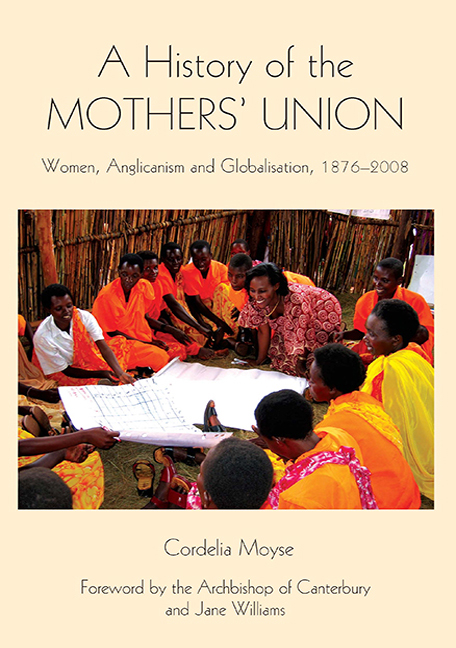Book contents
- Frontmatter
- Contents
- Dedication
- List of Illustrations
- Foreword by the Archbishop of Canterbury and Jane Williams
- Acknowledgements
- Abbreviations
- Introduction
- Part I 1876–1909
- 1 Launching the Mothers’ Union
- 2 Identity and Spirituality
- 3 Marriage and Family Life
- 4 Membership and Worldwide Work
- Part II 1910–1944
- Part III 1945–1974
- Part IV 1975–2008
- Conclusion
- Appendix 1 Text of early membership cards
- Appendix 2 Development of the Mothers' Union prayer
- Appendix 3 Midday prayers (original)
- Appendix 4 Development of the objects
- Appendix 5 Biographical notes on central and worldwide presidents
- Bibliography
- Index
- Miscellaneous Endmatter
1 - Launching the Mothers’ Union
from Part I - 1876–1909
Published online by Cambridge University Press: 29 April 2017
- Frontmatter
- Contents
- Dedication
- List of Illustrations
- Foreword by the Archbishop of Canterbury and Jane Williams
- Acknowledgements
- Abbreviations
- Introduction
- Part I 1876–1909
- 1 Launching the Mothers’ Union
- 2 Identity and Spirituality
- 3 Marriage and Family Life
- 4 Membership and Worldwide Work
- Part II 1910–1944
- Part III 1945–1974
- Part IV 1975–2008
- Conclusion
- Appendix 1 Text of early membership cards
- Appendix 2 Development of the Mothers' Union prayer
- Appendix 3 Midday prayers (original)
- Appendix 4 Development of the objects
- Appendix 5 Biographical notes on central and worldwide presidents
- Bibliography
- Index
- Miscellaneous Endmatter
Summary
No history of the Mothers’ Union can begin without considering its founder, Mary Sumner. She was not one of George Eliot's nineteenth-century St Theresas ‘who found themselves no epic life wherein there was a constant unfolding of far-resonant action’. Mary Sumner led an epic Christian life, or as close to one as a middle-class English woman could come. She led the MU from its inception in her living room in 1876 until her retirement as Central President in 1909, after which she was its oracle until her death in 1921 and its touchstone thereafter. By 1921 membership stood at 400,000 and the organisation had a truly global reach. Observers tried during her lifetime to explain the MU phenomenon by analysing her personality. Mary was credited with a unique drive and passion for her cause, a true singleness of heart as well as a charming persistence. These were, it was asserted, combined with a sense of timing similar to that of Hannibal and Charles Wesley. Writing about her after her death, MU historians, themselves members of the organisation, indulged in a kind of hagiography not often seen inside the Church of England. Sumner is presented as God's faithful servant who was not only inspired to start the MU, but was given unerring judgement, superhuman energy and unsurpassed organisational skills. These histories convey a sense of divine inevitability and deliberately fail to convey any sense of struggle, conflict or compromise, within the organisation or with the wider world.
Perversely, however, to understand the magnitude of Sumner's achievement it is necessary to look outside the model of the legendary heroine and instead situate her in a matrix of church and family networks as well as a maelstrom of conflicting models regarding the appropriate expression and organisation of women's Christian vocation. The most contentious and obvious examples of the ‘feminisation of piety’ in the mid to late nineteenth century were the emergence of religious sisterhoods and the order of deaconesses, but ordinary women in the pew were joining groups which offered them a more accessible womanly Christian vocation. What fuelled the explosion of lay women's groups and meetings was a desire to channel what was seen as women's vocation for motherhood, whether biological or social, in ways that strengthened the home and nation.
- Type
- Chapter
- Information
- A History of the Mothers' UnionWomen, Anglicanism and Globalisation, 1876–2008, pp. 17 - 42Publisher: Boydell & BrewerPrint publication year: 2009



